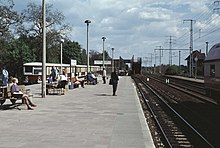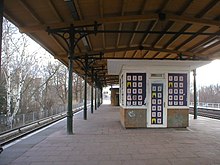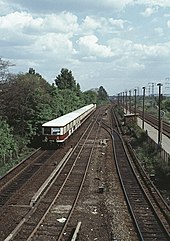Berlin-Karlshorst train station
| Berlin-Karlshorst | |
|---|---|
|
South entrance to the train station, 2005
|
|
| Data | |
| Location in the network | Through station |
| Platform tracks | 2 (S-Bahn) |
| abbreviation | BKLH (S-Bahn) |
| IBNR | 8089193 (S-Bahn) |
| Price range | 3 |
| opening | May 1, 1895 |
| Website URL | sbahn.berlin |
| Profile on Bahnhof.de | Berlin-Karlshorst |
| Architectural data | |
| architect |
Karl Cornelius Waldemar Suadicani |
| location | |
| City / municipality | Berlin |
| Place / district | Karlshorst |
| country | Berlin |
| Country | Germany |
| Coordinates | 52 ° 28 '51 " N , 13 ° 31' 33" E |
| Railway lines | |
|
|
| Railway stations in Berlin | |
The station Berlin-Karlshorst is a train station in the same Berlin district Karlshorst in Lichtenberg . Until 2017 it was also used for regional traffic, since then it has only been served by trains of the Berlin S-Bahn .
history
The station was put into operation on May 1, 1895 on the Lower Silesian-Märkische Bahn under the name Carlshorst , initially less for suburban traffic than for visitors to the obstacle course built in 1893/1894 . A six-track terminus station was built especially for this purpose next to the suburban platform - with a reception pavilion for the Kaiser at the confluence of Lehndorff and Wandlitzstrasse. In 1901 the town was renamed and with it the train station in Karlshorst . With the elevation of the route by 1902, today's station building and the bridge over what is now Treskowallee were built . In 1928 the electric S-Bahn was started on the route between Erkner and Potsdam . The traffic at the train station, still largely due to visitors to the racetrack, recorded its greatest numbers in these years.
After the Second World War , in July 1945, the long-distance tracks on the line were briefly switched to Russian broad gauge . The Soviet dictator Stalin was a participant in the Potsdam Conference and insisted on the possibility of traveling without changing trains. The reverse gauging to standard gauge took place in September of the same year. Since the line was the most important connection to the Soviet Union , the long-distance tracks were spared dismantling, but both suburban tracks were removed to compensate. It was not until 1947 that S-Bahn trains were able to use the newly laid tracks and thus return to Karlshorst.
Extension to the regional train station

When the GDR internal traffic no longer ran through West Berlin from 1952 , the Ostbahnhof had become a terminus for them, which was heavily used as a result. That is why it was planned in the early 1960s to expand Karlshorst station as another long-distance station for East Berlin . The station was to be relocated from the south-east to the north-west side of Treskowallee and a 600-meter long long-distance platform was to be built. The new two-storey reception building was to be built on Wandlitzstrasse / Lehndorffstrasse. A ten-meter-wide pedestrian tunnel between Lehndorffstrasse and Dönhoffstrasse for access to the S-Bahn and long-distance platforms was provided under the railway systems. Only the S-Bahn platform should have access from Treskowallee. To do this, the bridge over Treskowallee would have been widened. An eight-story administration building for the Reichsbahn was to be built next to the station building.
After the wall was built on August 13, 1961, the station got a regional platform. Since the S-Bahn trains to Potsdam could no longer run through West Berlin , new shuttle trains between East Berlin and Potsdam had to be routed over the outer ring . Karlshorst presented itself as the most suitable station for these trains called " Sputnik ". In addition, some trains to Frankfurt (Oder) stopped at the station during the GDR era . At certain times, Karlshorst was also the terminus of some D-trains when the capacity of the other Berlin long-distance stations was insufficient.
While the southern regional platform, like the S-Bahn platform, was accessible through an underpass, the staggered northern regional platform could only be reached via a pedestrian bridge that led there from the S-Bahn platform.
Modernization after 1990
The regional train station was always a temporary solution. This is particularly evident in the connection to the platform for trains from the east, which was difficult to reach via a pedestrian bridge at the rear end of the S-Bahn platform. In 2007, Deutsche Bahn replaced the long-distance railway superstructures over Treskowallee with auxiliary bridges due to their dilapidation. Between May 2010 and May 2011 the eastern access tunnel was extended to the north to Stolzenfelsstraße and a small forecourt was created there, giving the station another access to the S-Bahn platform. The state of Berlin bore the cost of 850,000 euros.
In the implementation of the Berlin - Frankfurt (Oder) upgraded line project, the long-distance railway tracks in the area of the Berlin-Karlshorst train station were expanded and the Treskowallee railway overpass completely renovated. Due to its age and extensive damage, the bridge had to be rebuilt. The clear width was increased from 15.75 meters to 31.50 meters. As part of the expansion of Treskowallee, the tram stop is then to be relocated under the bridge, with stops at the edge of the road. The associated planning approval decision was published on October 14, 2011.
After several postponements, construction began at the beginning of 2012. The estimated construction time was two years and four months. In May 2012, the old bridge superstructures over Treskowallee were excavated and replaced by auxiliary bridges in order to be able to rebuild the abutments under their protection. After the completion of the new abutments, the first new steel superstructure with a weight of 240 tons was lifted in June 2013 to accommodate the two long-distance railway tracks. The superstructures for the two S-Bahn tracks and the new pedestrian overpass were lifted in at the beginning of October 2013, after which double-track S-Bahn operations were restored. The completion of the construction work was planned for April 2014.
During construction work to build the new pedestrian overpass on October 12, 2013 at around 5 p.m., a seven-ton bridge section fell six meters to the floor of the station concourse. Two construction workers were seriously injured and one construction worker was slightly injured. A seriously injured person died after a few hours in the accident hospital in Berlin . The crashed bridge element could only be recovered and used in February 2014. The time schedule for completion was thus clearly exceeded.
In February 2015, an additional pedestrian bridge created another access on the west side of Treskowallee (with elevator and staircase). The original direct access from Treskowallee in the eastern abutment was reopened and the ticket office located there was removed.
With the opening of the lower regional platform at Ostkreuz station on December 10, 2017, the Karlshorst regional station was finally abandoned. An additional stop would have led to route conflicts and undershooting the buffer times. In addition, the pedestrian bridge and the regional platforms were largely worn out and would have had to be rebuilt for continued operation. These facilities were dismantled in 2018.
future
After completion of the bridge construction, the road expansion of Treskowallee and the relocation of the tram stop under the bridge are in progress in coordination between the district of Lichtenberg, BVG and Berliner Wasserbetriebe (as of May 2019). Due to coordination problems and a necessary separate planning approval procedure , completion before 2020 is not realistic.
Since July 2018, the S-Bahn platform has been completely renewed taking into account monument protection requirements, the eastern exit is to be enclosed and its underpass under the long-distance railway tracks is to be rebuilt. The cost of the renovation is estimated at seven million euros. Due to insufficient planning preparation, the work could not be completed as planned during the six-week total closure in summer 2018. The platform first had to be provisionally prepared. It was also announced that the listed supervisory building was demolished at short notice and without a permit in the course of the renovation work. Completion is scheduled for 2020.
Transport links
Karlshorst station is served by the S-Bahn line S3 Spandau - Erkner .
Since 1998, the station has not been served by regional trains from Potsdam via the southern Berlin outer ring, which have been running since the Wall was built in 1961 ("Sputnik"). The stop for regional express trains in the direction of Frankfurt (Oder) was canceled a year later. Regional traffic at Karlshorst station was suspended on December 10, 2017. Most recently, the lines RE 7 Dessau - Berlin - Berlin-Schönefeld Airport - Wünsdorf -Waldstadt and RB 14 Nauen - Berlin - Berlin Schönefeld Airport served the station.
Around 4,100 passengers per day used the regional stop in the first half of 2017, the S-Bahn station is frequented by around 12,000 passengers per day (as of 2016).
The station is connected to the public transport network by tram lines M17, 27 and 37 as well as bus lines 296 and 396.
| line | course |
|---|---|
|
|
Spandau - Stresow - Pichelsberg - Olympiastadion - Heerstraße - Messe Süd - Westkreuz - Charlottenburg - Savignyplatz - Zoological Garden - Tiergarten - Bellevue - Central Station - Friedrichstraße - Hackescher Markt - Alexanderplatz - Jannowitzbrücke - Ostbahnhof - Warschauer Straße - Ostkreuz - Rummelsburg - Rummelsburg depot - Karlshorst - Wuhlheide - Köpenick - Hirschgarten - Friedrichshagen - Rahnsdorf - Wilhelmshagen - Erkner |
literature
- Bernd Kuhlmann: 125 years ago: Berlin-Karlshorst racing station opened. In: Verkehrsgeschichtliche Blätter , Volume 46, Issue 2 (March / April 2019), pp. 46–51.
Web links
- Entry in the Berlin State Monument List
- Berlin-Karlshorst train station on stadtschnellbahn-berlin.de
- Information and pictures of the construction process on bastellen-doku.info
Individual evidence
- ↑ Station price list 2020. In: Deutsche Bahn. Deutsche Bahn, January 1, 2020, accessed on July 11, 2020 .
- ↑ Query of the course book route 200.3 at Deutsche Bahn.
- ↑ Query of the course book route 207 at Deutsche Bahn.
- ↑ Query of the course book route 209.14 at Deutsche Bahn.
- ^ Bettina Vaupel: Very Highest Railway. From imperial train stations, princely rooms and saloon cars . In: Monumente , 23rd vol. (2013) No. 3, pp. 9–17 (10).
- ↑ Bernd Kuhlmann: the railway. On the history of the railway in and around Karlshorst . Kulturring in Berlin, Berlin 2011, pp. 84–87
- ^ Karlshorst station becomes a metropolis station. In: Neue Zeit , April 5, 1962, p. 8
- ↑ a b Planning approval decision: EÜ Treskowallee. (No longer available online.) Federal Railway Office , October 14, 2011, archived from the original on April 8, 2014 ; Retrieved May 7, 2012 .
- ^ Karlshorst - From May 4th also from Stolzenfelsstrasse to the S-Bahn platform. (No longer available online.) S-Bahn Berlin GmbH, May 2, 2011, archived from the original on December 16, 2014 ; Retrieved May 17, 2012 .
- ↑ Planned construction work on the railway overpass (EÜ) Treskowallee in 2012. (PDF; 866 kB) (No longer available online.) DB Projektbau GmbH, January 12, 2012, archived from the original on January 31, 2012 ; Retrieved January 23, 2012 .
- ↑ Lifting in the first new bridge parts: 240-ton steel superstructure remote-controlled on s-bahn-berlin.de
- ↑ Technology spectacle at the railway bridge in Karlshorst. S-Bahn Berlin GmbH, September 27, 2013, accessed on September 27, 2013 .
- ↑ Construction worker dies after a serious accident while working on a bridge. In: Der Tagesspiegel . October 12, 2013. Retrieved October 13, 2013 .
- ↑ Elevator and pedestrian bridge at Karlshorst station - new western access near Dönhoffstrasse and Wandlitzstrasse. on www.bahnbilder.de
- ^ Off for the regional train station: On December 9th, the last regional train stops in Karlshorst. In: Berlin Week . October 9, 2017. Retrieved November 9, 2017 .
- ↑ Presentation of the BVG-BWB coordination project Treskowallee / S-Bahn station Karlshorst
- ^ Trouble about the construction site in Karlshorst . In: LichtenbergMarzahnPlus , February 3, 2018
- ↑ Printed matter 18/12384. (PDF) Berlin House of Representatives, October 16, 2017, accessed on November 3, 2017 .
- ↑ Printed matter 18/17433. (PDF) Berlin House of Representatives, January 23, 2019, accessed on February 6, 2019 .
- ↑ Current plans for Karlshorst train station on andreas-geisel.de
- ↑ Printed matter 18/12864. (PDF) Berlin House of Representatives, December 12, 2017, accessed on March 13, 2018 .






